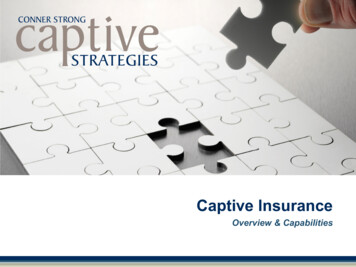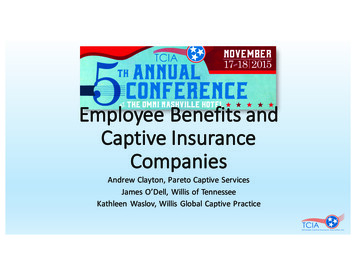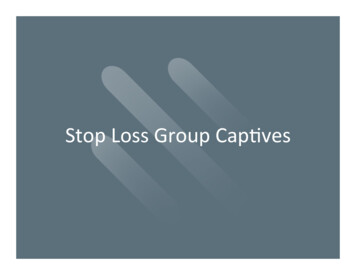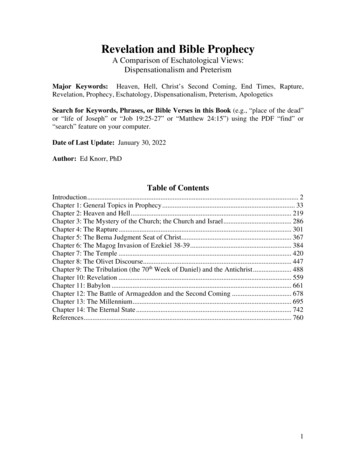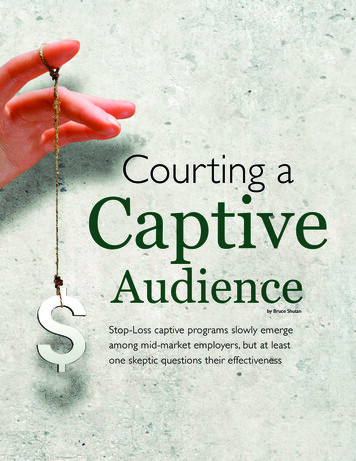
Transcription
Courting aCaptiveAudienceby Bruce ShutanStop-Loss captive programs slowly emergeamong mid-market employers, but at leastone skeptic questions their effectiveness44October 2014 The Self-Insurer Self-Insurers’ Publishing Corp. All rights reserved.
Andrew Cavenagh,president of ParetoCaptive Services, LLC,recalls how a midsizeemployer client called one day tocomplain about spending 100,000on workers’ comp, but as much as 1 million on benefits – wondering ifthere was a strategy to get the latterto look more like the former. Then hehad an epiphany: What if the promisingP&C group captives he worked on atthe time could be replicated for theemployee benefits space?Welcome to the world of stoploss captive programs (also knownby some as employee benefit groupcaptives), which create a shockabsorber of sorts that reduces riskand volatility that a 100 or 200 lifegroup would normally have if theyself-insured.The programs have caught onin recent years because they givemembers “the ability to have a senseof shared accountability to eachother in terms of utilization claimsexperience that is difficult to getwhen you’re part of a large, fullyinsured pool, where you don’t haveany credibility,” says Jeff Fitzgerald, VPof employee benefits at InnovativeCaptive Strategies.What’s worth noting is that pricestability and credibility are in shortsupport for groups of 100 to 400covered lives that Fitzgerald says are“told they’re not big enough to matterbecause they’re part of such a largeblock of a big, fully insured carrier.”The number of stop-loss captiveprograms has gone from a handful tonearly 100 arrangements over the pastseven years or so, he observes – withanywhere from five to 100 members.He has seen huge growth in the pasttwo or three years, particularly in the“heterogeneous” space involving 100to 400 covered lives on a plan. “It’s stilla very small part of the industry,” heacknowledges, “but if you’re lookingat groups of that size throughout thecountry, that’s an almost uncountablenumber of employer groups.”A 2013 Milliman reportcommissioned by the Self-InsuranceEducational Foundation estimated thatabout one-quarter of the employermedical stop-loss market serves 100 orfewer covered employees as measuredby the number of employers. Thatsame segment represents only 2%of the market when measured bycovered employees, according tothe report, which was based on dataprovided by eight of the nation’slargest stop-loss carriers servingabout 50% of the market.The Wrong FocusWhile these captives may becommanding attention among midmarket employers, there are skepticswho dismiss them as ineffective. Thefact is that nearly 98% of the selffunded employer market does notparticipate in captives, explains MattRhenish, president and COO of HMInsurance Group. He says self-fundedemployers should devote most oftheir time, energy, resources anddollars to managing claims, which driveat least 85 of every 100 in healthcare costs. The trouble with captives isthat they attempt to reduce only a tinypart of overall cost, which is to get abetter handle on stop loss.“That’s an important thing to do,”he admits, “but it’s significantly lessrelevant considering it has significantlyless impact on a client’s overallfinancial situation than managing firstdollar claims and claims overall.”Rhenish is unconvinced that theseprograms offer a better way for selfinsured employers to manage theirclaims relative to other mechanisms,such as changing deductibles or Self-Insurers’ Publishing Corp. All rights reserved.tightening plan documents, that can bedone, irrespective of a captive.Another issue is the level ofcomplexity associated with thesearrangements. “In some cases, youhave to put in up-front capital to fundthe captives and there are ongoingcosts,” he explains. “Those are all coststhat don’t really help reduce youroverall claims costs. Maybe you canmanage the middle layer a little bitbetter, but that middle layer is going tobe what, 5% of your total claims cost?You’re going to manage it 10% better?”Rhenish points out that bandingtogether will merely extend or sharerisk across the populations of othercaptive members rather than actuallymanage the risk in any meaningful way.“We can’t just make risk disappear,”he says, suggesting that mid-marketemployers instead “write a straightstop-loss contract that mirrors theunderlying plan document.”Three Programs in OneBut others see promise in thisapproach. Cavenagh was so bullishabout captives that he actuallyquit the large insurance companyhe’d been working for in 2010because of a “strong belief that thecaptive management role should beindependent from both the brokerand stop-loss carrier.”Comparing these arrangements toa three-legged stool that’s groundedby the employer, stop-loss companyand group captive, a Pareto CaptiveServices white paper cautions that“if any of these contracts is notnegotiated at arm’s length, thestructure is weakened. It is difficult tohave an arm’s length transaction if thesame entity is negotiating two sidesof an agreement.”Cavenagh describes stop-losscaptives as essentially three programswrapped up into one, including aThe Self-Insurer October 201445
traditional layer of self-insurance for,say, up to 25,000 per individual andsome aggregate stop loss; the captive,or shock-absorbing layer from 25,000to 250,000; and traditional excessor stop-loss for the portion of claimsabove 250,000 per individual.employers will buy a stop-loss policy from a carrier that is going to enter into areinsurance agreement with a captive that will give a portion of the premiumscollected to each employer and the captive is now responsible to pay claimsbetween 25,000 and 250,000.An employer with a 100,000claim will pay 25,000 and thenrequest 75,000 from the stoploss captive program, and if there’sany money left over at the end ofthe year, it’s given back to all theemployers that are part of thisarrangement. If they run out ofmoney, then the same carrier that hasagreed to pay the catastrophic claimsagrees to step in and pay claims.Key objectives of these programs include a search for greater transparency inclaims data as part of a partnership approach that leverages the involvement ofmany smaller employers, according to Fitzgerald, a member of SIIA’s AlternativeRisk Transfer Committee, which he says is always on the lookout for medical stoploss and enterprise risk captives for small businesses.The employer technically isn’tbuying a policy from the captive, butrather an “admitted” or “fronting”carrier that will pay all claims in excessof 25,000, according to Cavenagh.In this example, all of the captive“That’s a very important twist from a regulatory standpoint, because acaptive itself is there for not issuing policies in 50 states around the country,which would be illegal,” he explains.The appeal of these programs isn’t confined to a particular employer orindustry. While a construction company that offers wellness incentives certainlywould fare better than a white-collar group that’s full of smokers, he says “it’smore about having groups of a like mind” that want to share in the risk.ACA Program AcceleratorFitzgerald predicts that the Affordable Care Act’s (ACA) reportingrequirement, which takes effect in 2015, will create the opportunity for analternative risk vehicle “because the exchanges aren’t interesting for everybodyand the traditional insurance market is really having trouble pricing these groups.”Captive programs can help serve the significant number of working AmericansBROADVISIONUNDERWRITERS (BVU)YOUR VALUED STOP-LOSS PARTNERBVU is a Managing General Underwriter(MGU) specializing in the underwritingand placement of Stop-Loss andaggregate coverages.An MGU that values your relationshipwith your clients as much as you do.To learn more about what makes BroadvisionUnderwriters unique, visit our website:www.BroadvisionUnderwriters.comDon’t forget to join our Mailing List while you are there!You can also contactGail Williams, Stop Loss Coordinator for BVU, at:Gail.Williams@Broadvision.comor (630) 203-5126Broadvision Reinsurance: 6685 Telegraph Rd. St. Louis, MO 63129 314.293.9708Broadvision Underwriters: 225 Smith Rd. St. Charles, IL 60174 855.346.239746October 2014 The Self-Insurer Self-Insurers’ Publishing Corp. All rights reserved.
2013 Helmsman Management Services LLC.WE CAN HELP YOU LOWERYOUR COSTS,EVEN FOR YOUR MOSTCOMPLEX CLAIMS.Thankfully, catastrophic and complex claims don’t happenoften. But when they do, they can result in significantlosses for your business and significant injury to yourvalued employees. A compassionate claim professionalwith the right resources and experience can make all thedifference in bringing about a positive outcome for youand your injured worker. To learn more, ask your brokeror visit helmsmantpa.com. Self-Insurers’ Publishing Corp. All rights reserved.The Self-Insurer October 201447
SOLUTIONS.SERVICE.INSIGHTS.WITH AmWINS GROUP BENEFITS,YOUR CLIENTS GET THE TOTAL PACKAGE.When you partner with AmWINS, you can help your clients select froman extensive range of products and administrative solutions, includingmedical stop loss, small group self-funding, audit services, caremanagement, dialysis management solutions and healthcare benefitsadministration. We provide them with seamless customer service throughour proprietary administrative systems, and you keep them in the knowwith timely insights from our practice experts — ensuring you’re the firstplace they turn for new program information.To learn more about offering your clients the most comprehensive self-fundedhealthcare solutions, visit amwins.com.48October 2014 The Self-Insurer Self-Insurers’ Publishing Corp. All rights reserved.
who have never been offered benefits by appealing largely to entrepreneurialbusiness owners who are seeking more control over the pricing of these benefits,he observes. They may include anyone from franchise owners, staffing agenciesand professional employer organizations to construction companies and retailstores that employ many hourly and cyclical workers who may not have qualifiedas full-timers in the past.Another key trend that he sees tied to the ACA is that more carriers areprohibited from pricing or banding their rating of groups by age, gender or evenclaims experience. “Insurance companies are going to basically be underwriting ona platform that makes it difficult to differentiate themselves because of the bandsthat they’re locked into,” Fitzgerald says.As a result, he believes better performing groups are going to be subsidizingweaker performing groups without any incentive to do better. The ACA alsowill continue to drive members who are already serious about wellness andcost-containment strategies “into these sorts of vehicles so that they can berewarded for the work that they’re putting forward and have some of their ownsay in the ratings rather than the shrunken rating bands that are going to beallowed by the carriers,” he adds.In spite of what Rhenish saysabout captives, Cavenagh expects“exponential growth” for theseprograms as well as his own company,calling the ACA an accelerant if notan actual cause. “It wouldn’t shock meif in the next year it’s a 500 millionstop-loss business,” he says. nBruce Shutan is a Los Angeles freelancewriter who has closely covered theemployee benefits industry for morethan 25 years.Stop-loss captive programs seek a common thread, which Cavenagh describesas “temperament of ownership” – the most important determinant. One suchexample is a refusal to pay a 15% increase to Blue Cross with no usable claimsdata and terrible population management. 77(17,21 6(/) ,1685(' ,1'8675 ,W'V safe WR VWHS RXt RI WKH ER[ /HDUQ PRUH DERXW RXU UHYROXWLRQDU\ VROXWLRQV IRU &KURQLF .LGQH\ 'LVHDVH Call Us Today 1-866-265-1719 or Visit www.dccinc-us.com Self-Insurers’ Publishing Corp. All rights reserved.The Self-Insurer October 201449
president of Pareto Captive Services, LLC, recalls how a midsize-employer client called one day to complain about spending 100,000 on workers’ comp, but as much as 1 million on benefits – wondering if there was a strategy to get the latter to look
